This recipe for classic Texas style smoked brisket is both delicious and surprisingly simple to make. In this step-by-step guide, you’ll learn all the tips about brisket cook time per pound, what temp to wrap brisket, the optimal temperatures for the brisket is done, and the best wood for smoking brisket.
Smoking a brisket can be intimidating at first, but we’ve broken down the best way to smoke brisket into simple, approachable steps to ensure success on your very first attempt.
It all starts with a simple two-ingredient rub, then it smokes low and slow for hours and hours to perfection. Not only will your guests not be able to get enough, but you will be eating like a king with all the wonderful brisket leftovers!
Learn the best way to smoke a brisket with this tried-and-true method influenced by Aaron Franklin’s gold-standard techniques. Start with high-quality meat, smoke low and slow at a constant temperature, and let the brisket rest for at least an hour before slicing. Whether using a kamado grill, a Traeger pellet smoker or a box smoker, just follow these steps and your brisket is going to turn out great.
Tools You’ll Need
Here are some important tools & equipment that will make this whole process easier. Check out the full list of smoker accessories and tools I recommend most.
- Smoker – A pellet smoker like a Traeger, electric smoker or a charcoal smoker will all work great. You will also need pellets or wood chunks, depending on the type of smoker you have.
- Sharp knives – A boning knife is perfect for trimming the fat and silver skin and a slicing knife for slicing the cooked brisket for serving.
- Two-zone remote probe thermometer to remotely monitor the temperature of your smoker along with the internal temperature of the brisket.
- Meat thermometer – I recommend the Thermapen instant-read probe thermometer to precisely test and verify the internal temperature in different areas.
- Butcher paper – For wrapping the brisket. I prefer the 24-inch width for easier wrapping. You can totally use aluminum foil (aka the Texas crutch) if you have that on hand.
- Large cutting board – for both trimming and slicing the brisket.
How to Smoke a Brisket
These are basic steps to follow. Jump down to the full recipe card for all the details and learn more in the Brisket 101 Quick Guide.
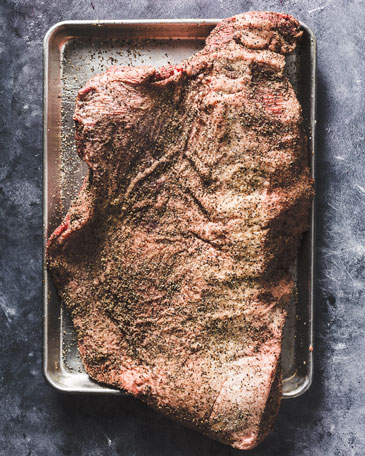
Step 1: Buy Your Brisket
Choose a high-quality whole “full packer” cut that contains both the flat and the point. I recommend USDA Prime for the most tender and flavorful results.
Tip: Figure 1 pound of raw untrimmed brisket per person choosing the size of your brisket.
Learn more about where and how to buy brisket →
Step 2: Trim the Brisket
Trim off any loose pieces and shave the fat cap down to about 1/4″ thick with a boning knife. Remove the silver skin from the bottom and trim the edges.
The goal is to create a tidy, evenly shaped surface that is optimal for airflow over it and void of pieces that could burn. You want to leave enough fat to protect the meat, but remove anything you won’t want to eat.
You can spend as little or as much time trimming as you want.
Learn How to Trim a Brisket →
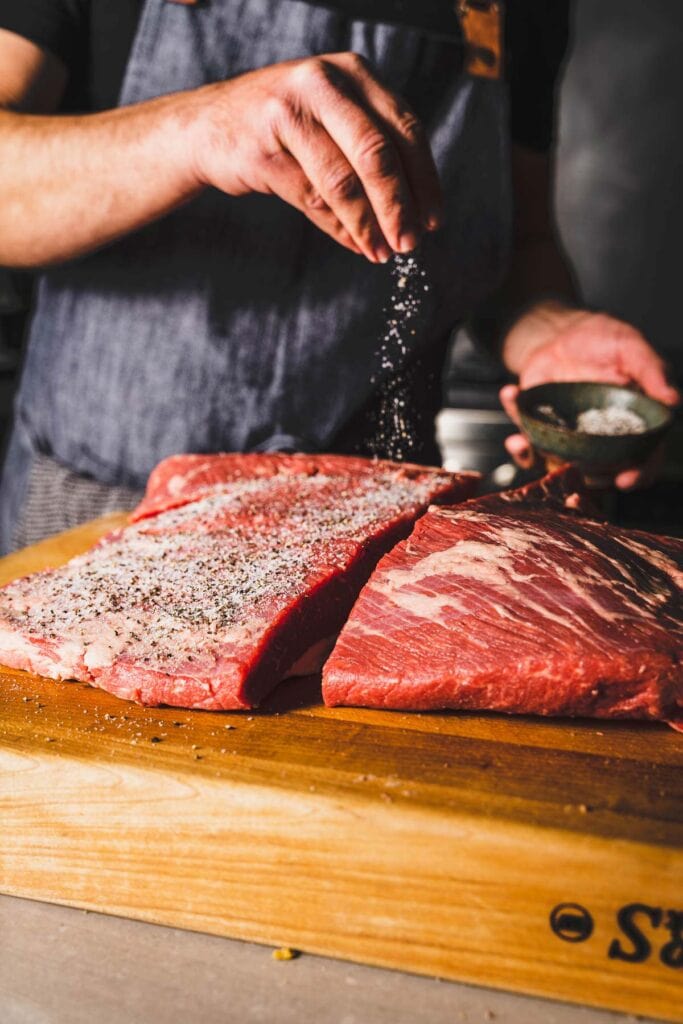
Step 3: Season the Brisket
Season it generously on all sides with a simple 50:50 ratio of kosher salt and 16 mesh coarse ground black pepper. Feel free to add some garlic powder, smoked paprika or even a little brown sugar if you prefer.
Get the Brisket Rub Recipe with Additional Ingredient Options →
Let the brisket sit out on the counter for at least one hour after seasoning it before cooking. Place a remote probe thermometer in the thickest part of the brisket.
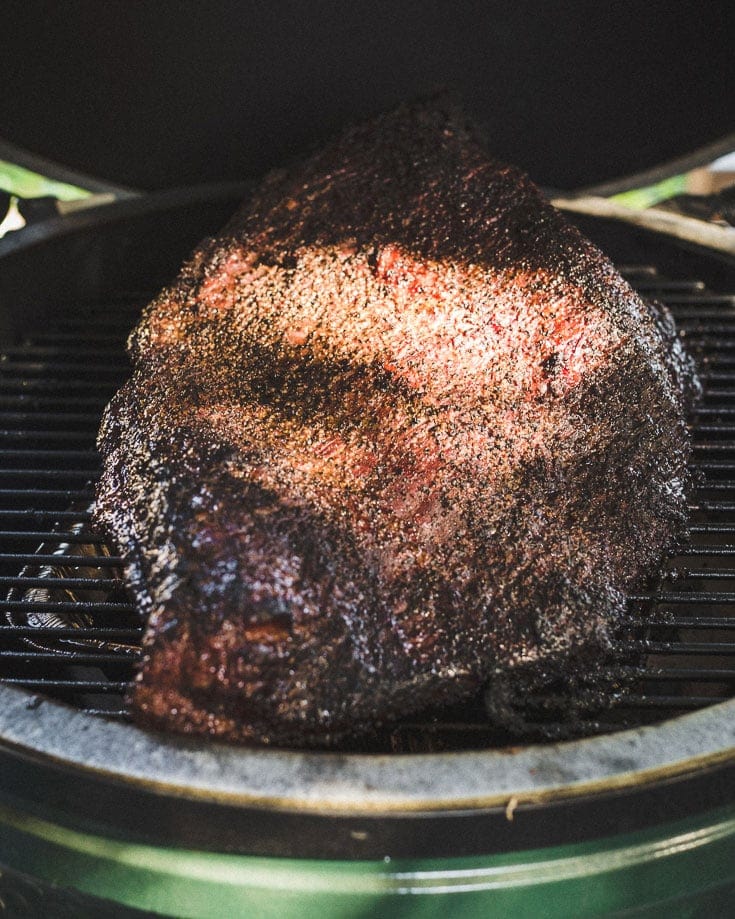
Step 4: Smoke the Brisket
Set up your smoker to use indirect heat cooking and bring the temperature between 225° F to 275° F with post oak or your preferred variety of wood for smoking brisket. Use a water drip pan and mount a thermometer to the grates so you know the actual temperature of the smoker.
Place the brisket in the smoker fat side down with the thicker ‘point’ closest to the heat source and smoke with the lid closed.
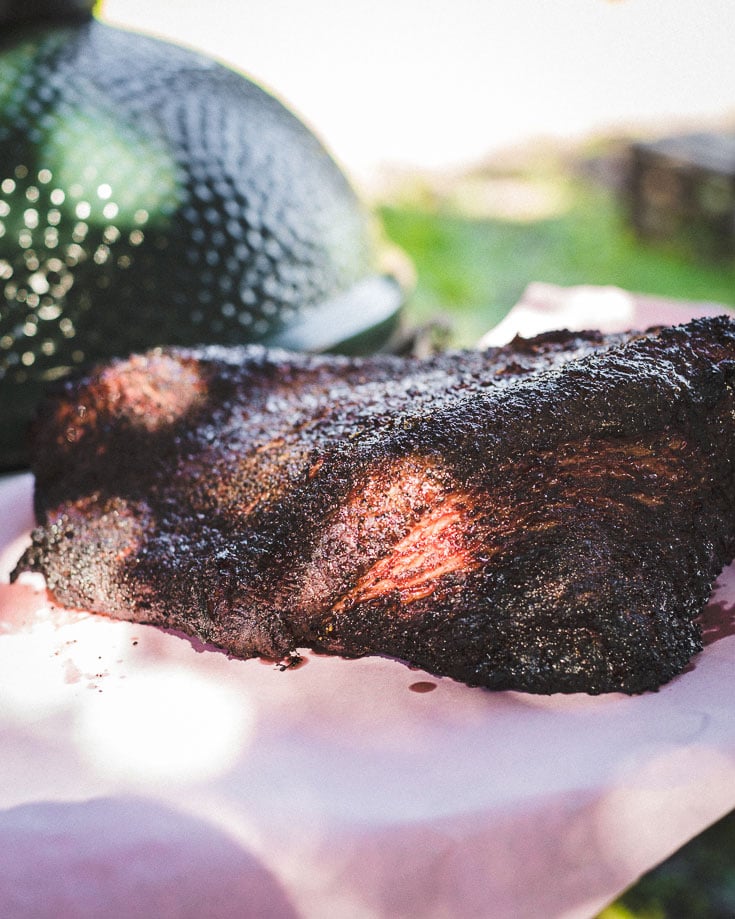
Step 5: Wrap the Brisket at 165° F
The best temp to wrap brisket is when the bark is formed and the internal temperature reaches 165° F. This will take around 4 to 6 hours+. Take the brisket out of the smoker and wrap it tightly with butcher paper or aluminum foil and then place it back in the smoker to finish cooking.
It’s finished when the Briskets Internal Temp reaches 203° F!
When the internal temperature of the flat (thinner side) reaches between 203° and 206° F, it should feel very tender and flexible to the touch. Verify with a probe thermometer, which should easily go into the meat without resistance.
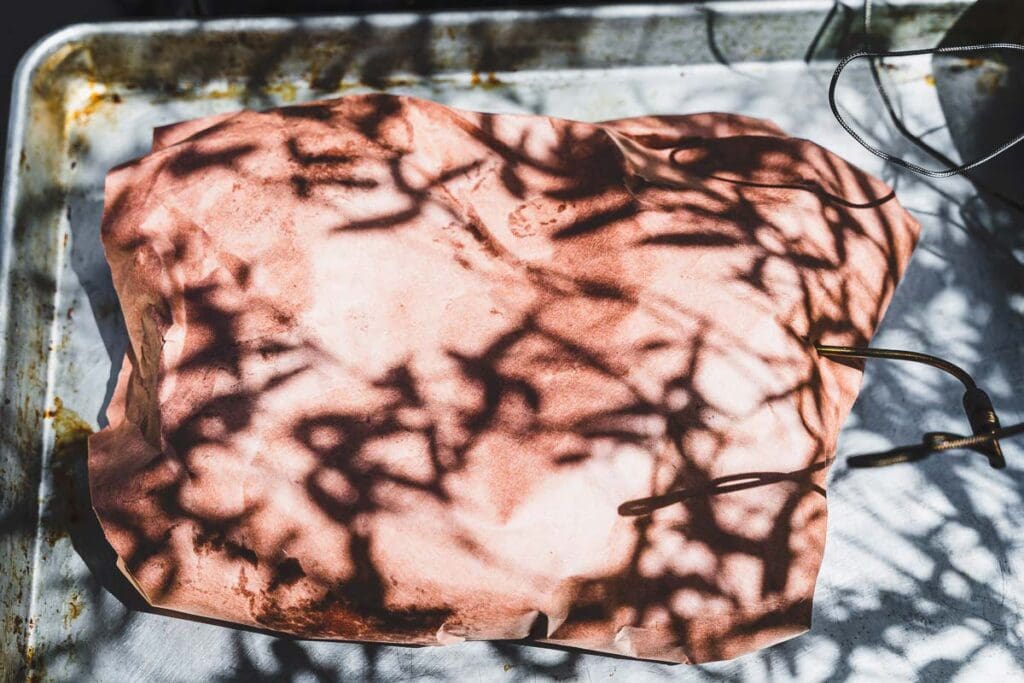
Step 6: Rest for 1 Hour +
Remove the brisket from the smoker and rest it for a minimum of 1 hour (longer is even better), leaving it wrapped so it can relax and redistribute the juices and cool slightly before slicing.
Tip: Place the wrapped brisket in a cooler lined with a towel. This will keep it nice and warm as it rests until you are ready to serve it.
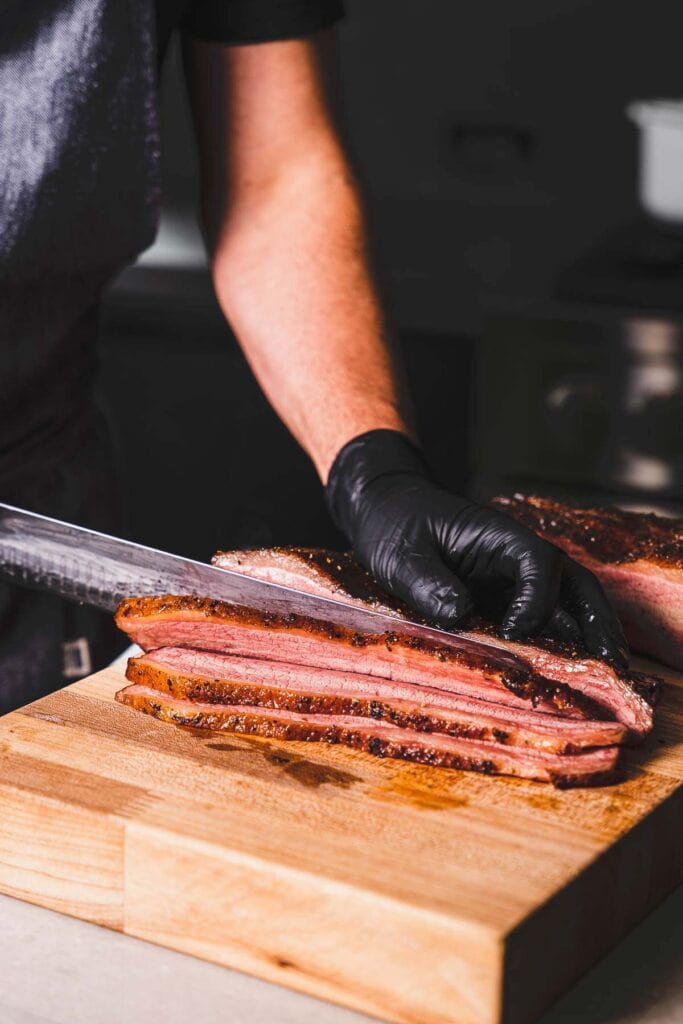
Step 7: Slice
First, separate the point from the flat muscle, which is easy to do once the meat is cooked. The grain is different for each, so you’ll want to slice them separately for optimal texture.
Slice against the grain using long strokes into 1/4” thick slices for the most tender brisket bites. This is the perfect brisket knife.
Tip: Slice to serve. Sliced brisket will dry out fairly quickly, so slice only what you will be serving right away and slice more as needed later.
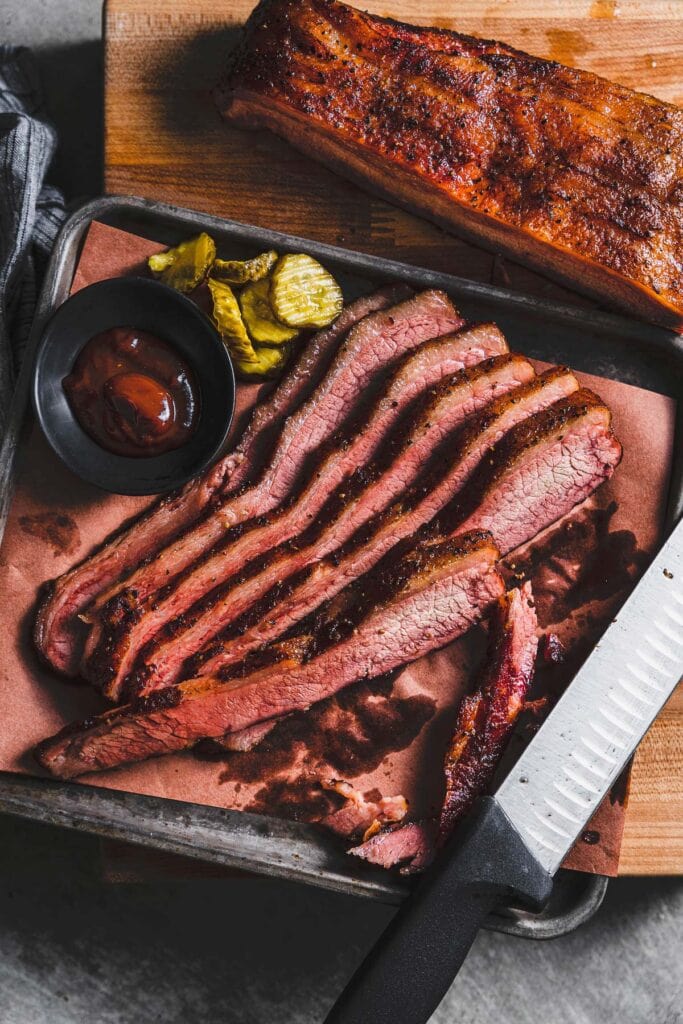
Step 8: Serve
Serve it up and enjoy your party with all the delicious side dishes for brisket.
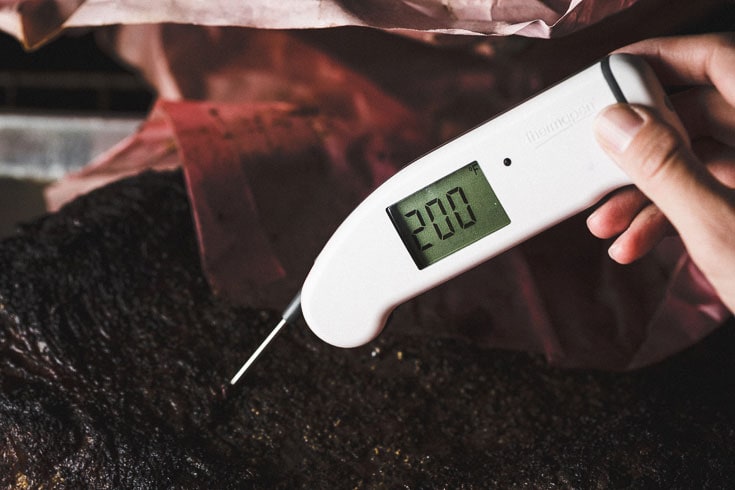
How Long to Smoke a Brisket?
It will take approximately 1 to 1 1/2 hours per pound in a 250° F smoker to bring the internal temperature up to 203° F.
A brisket is finished cooking when the internal temperature reaches between 203° and 206° F. While the time it takes to finish cooking can vary greatly depending on a lot of variables; there shouldn’t be any guessing as to when the brisket is finished cooking since you should cook to temperature, rather than by time..
For planning purposes, the cook time for a 14-pound brisket will be around 14 to 17 1/2 hours. But it’s really more the thickness of the meat and the temperature of your smoker that determines how long it will take, rather than its overall weight that determines the time.
Always use an instant-read meat thermometer to check the temperature, and even better is to use a Thermoworks Smoke Alarm so you can monitor it wirelessly without having to open the smoker.
Tip: Give yourself more time than you think you will need to cook it. Smoking meat always seems to take longer than you expect, so start early (even the night before) and just let it rest in a cooler for longer if it’s done early.
Brisket Cook Time Per Pound
| Cut | Weight | Smoker Temp | Cook Time (Approx) |
| Whole Packer | 14 to 18 lbs | 250° – 275° F | 12 to 18 hours |
| Flat | 6 to 8 lbs | 250° – 275° F | 6 to 10 hours |
Key Temperatures for Smoked Brisket
Smoker Temp: 225° to 275° F. Lower is safer, higher will cook faster and develop better bark. Use temps for pellet smokers as you will get more smoke flavor.
Temp to Wrap the Brisket: 165° F.
Brisket Internal Temp When Done: 203°-206° F.
Approximate Brisket Cook Time Per Pound: 1 to 1 1/2 hours per pound.
Rest: 1 to 2 hours or until the internal temp drops between 140° F and 145° F.
The Best Wood for Smoking Brisket
Wood for smoking often comes down to preference and can require experimenting to see the flavors you love best. Post Oak is traditional for Texas BBQ, but you can also add a combination including Apple Wood. Learn more about the best wood and pellets to use for smoking brisket.
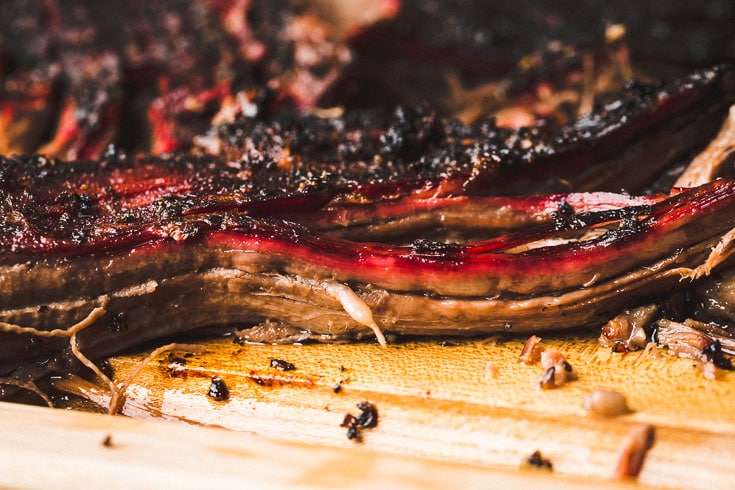
Top Tips for Success
Recipe Variations
- Use a slather – A slather is a binder applied to the surface of the meat to help the dry rub stick. It can be as simple as water, oil, mustard, or even beef tallow. If you are having trouble getting the rub to stick, you can apply a little slather before dusting on the rub, which really won’t change the flavor of the meat..
- Spritz if you wish – If you are worried about your brisket drying out, you can spritz it every 45 mins after the first two to three hours with cider vinegar and water or apple juice. This will keep the exterior from drying out and does help attract more smoke and form better bark. *I don’t personally spritz when smoking brisket as I would rather just leave the lid closed.
- Finish the brisket in the oven – After the brisket has reached at least 165° F and has great bark, it is totally fine to wrap it and finish it in a 275° F oven until it reaches the desired temperature.
- Sous Vide the brisket before smoking – If you are looking for an alternate cooking method, try this mostly hands-off sous vide brisket recipe which you can choose the texture.

Recipe FAQs
Generally, you want to smoke the brisket with the fat side down on the grates, closer to the heat source, helping the fat render. This is true for most pellet and charcoal smokers, but with offset smokers, you might place the fat side up as the heat comes in from the side. In my experience, either fat side up or down will work just about the same.
Once the bark has been formed and the internal temperature has reached around 165° F (which will take 4 to 6 hours+), wrap the brisket with butcher paper or aluminum foil and place back in the smoker until the internal temperature reaches between 201-205° F.
Rest the brisket for a minimum of 1 hour, but 2 or more hours is even better. Rest it in a cooler (still wrapped in butcher paper or foil). It might be tempting to rest it for less time, but it’s totally worth waiting. This gives all of the juices time to fully redistribute and will result in juicier and more flavorful meat.
Tip: Use the faux cambro technique by pre-heating your cooler with some hot water so it stays warm for longer. You can also wrap it in a layer of towels to keep it extra insulated. As long as the brisket’s temp stays above 140° F, it is safe.
Reheating brisket can be tricky, as it can easily dry out.
– In the Oven: Preheat the oven to 275° F (you can also use a grill or a smoker like an oven). Double wrap the brisket in foil (add in a splash of beef broth or beef tallow to make it extra juicy) and place it on a sheet pan and heat until the internal temperature reaches around 165° F, 30 to 60 minutes.
– Sous Vide: Vacuum seal the leftover brisket and place it in a 155° F water bath for 1 to 2 hours. Remove from the bag and enjoy.
– Skillet: While it’s going to change the texture a of the brisket a bit, heating it in a cast iron skillet is perfect when making brisket sandwiches or brisket tacos.
A brisket is finished cooking when the internal temperature of the flat reaches between 203° and 206° F is great. When testing, the probe should easily go in without resistance. If it is still giving resistance, then let it keep cooking it for longer until it is. This will make a big difference in the tenderness.
Use a remote thermometer so you can monitor the temperature wirelessly without having to open the smoker, then use an instant-read meat probe thermometer to spot-check and verify doneness in different parts of the brisket.
Figure 1 pound of raw untrimmed brisket per person. You will be trimming off about 20 to 40% and cooking out even more weight.
You can feed at least 15 people with a 15-pound brisket. At $3.89 per pound, that is less than $6 per person, which is some seriously great value.
Brisket is a giant, extremely tough primal cut of beef. There are two briskets per cow (one from each side) and they are the pectoral muscles, which are tough because of all of the work they do.
Each brisket is comprised of two muscles, the flat and the point. Each has a unique texture and cooks differently, which adds to the challenge of the cook. The size of the cut before trimming can range from 8 to 20 pounds.
While brisket is big and tough, it packs tons of flavor and is a perfect candidate for low and slow smoking.
Learn more in the Beginners Guide to Briskett →
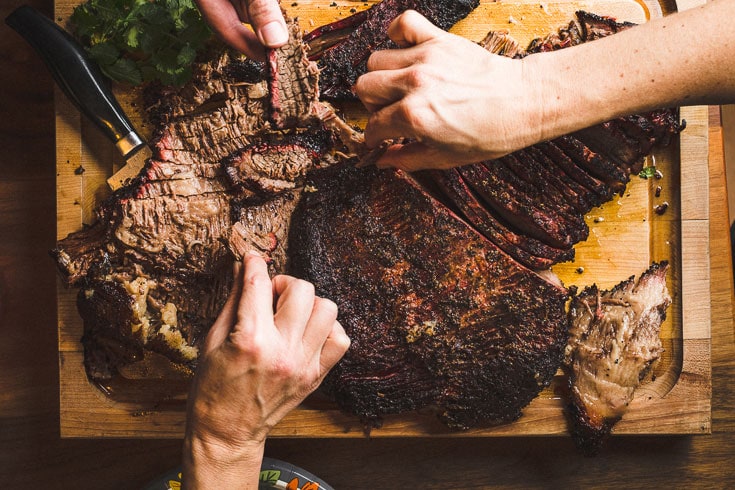
Brisket Sides
Serve it simply with bread & butter pickle
A fresh coleslaw is perfect because you can eat it on the side or put it on a brisket sandwich if you prefer. Baked beans, potato salad, and creamy macaroni salad are also great pairings. Keep the theme going by sipping a refreshing hot & smoky mezcal margarita.
Check out all the best sides to serve with brisket →
What to do with Leftovers
Make brisket sandwiches and omg good brisket ragu over pasta or polenta, tacos, breakfast brisket and egg hash for breakfast, a brisket grilled cheese for lunch, add it to baked beans, make chili, add it to ramen. You can make addicting burnt ends with the leftover point end. Okay, you get the point. It is good in just about anything and you are the lucky one who gets to indulge for hopefully a few days at the least.
More Smoker Recipes You’ll Love
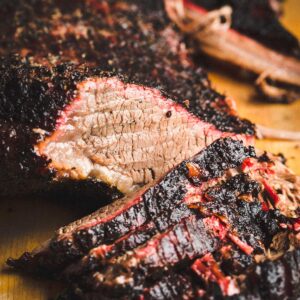
Smoked Brisket
Equipment
Ingredients
- 12 to 16 lb Prime grade whole packer brisket
- 1/2 cup Diamond kosher salt
- 1/2 cup coarse ground black pepper (16 mesh grind)
Instructions
- Trim the brisket while it is very cold using a sharp knife. Trim the fat cap down to about 1/4" thick and remove the silver skin from the backside.
- Season: Combine the Kosher salt and freshly ground black pepper in a small bowl or spice shaker, then evenly season the brisket on all sides. Let the brisket sit out at room temperature for 1 hour while you set up your smoker.
- Prepare the Smoker: Set up your smoker according to the manufacturer's instructions for indirect cooking with a water-filled drip pan in place. Bring the temperature between 225° and 275° F. Add 3 to 5 fist-size oak, pecan or your favorite wood chunks for smoke (if using a charcoal smoker).
- Smoke the Brisket: Place the brisket in the smoker fat side down with the thickest end closer to the heat. Leave the lid closed for at least 3 hours. Cook until the internal temperature reaches 165° F and a dark brown bark is formed, about 6 to 8 hours.
- Wrap the Brisket: Remove the brisket from the smoker and tightly wrap it with uncoated butcher paper (or aluminum foil). Place it back in the smoker and continue cooking until the internal temperature of the flat (thinner side) reaches between 203 and 206° F, about 6 to 8 hours more.
- Rest: Carefully transfer the brisket (still wrapped in the butcher paper) to a large cooler or cutting board to rest for at least 1 hour and preferably 2 hours or until the internal temp drops to 140 to 145° F. You can line the cooler with a towel to further insulate the brisket to keep it warm.
- Slice and Serve: Separate the point from the flat muscle, then slice against the grain (which is different for each muscle) into 1/4" slices just before serving. Enjoy with your favorite sides.
Video
Notes
- Smoker Temperature: For a pellet smoker, use a lower temperature of 225° F, and a higher temperature of 250-275° F for charcoal smokers.
- The Best Wood for Smoking Brisket: I prefer using oak wood chunks, but you can also use mesquite, pecan or add in a combination of cherry or apple depending on your preference.
- Thermometers are your best friend. Place a probe in the thickest part of the brisket flat, one on the smoker’s grate and use a handheld meat thermometer to spot check to verify at the end of the cook.
- Open the lid of the smoker as few times as possible during the cook.
- The cook time will be approximately 1 to 1 1/2 hours per pound at 250° F.

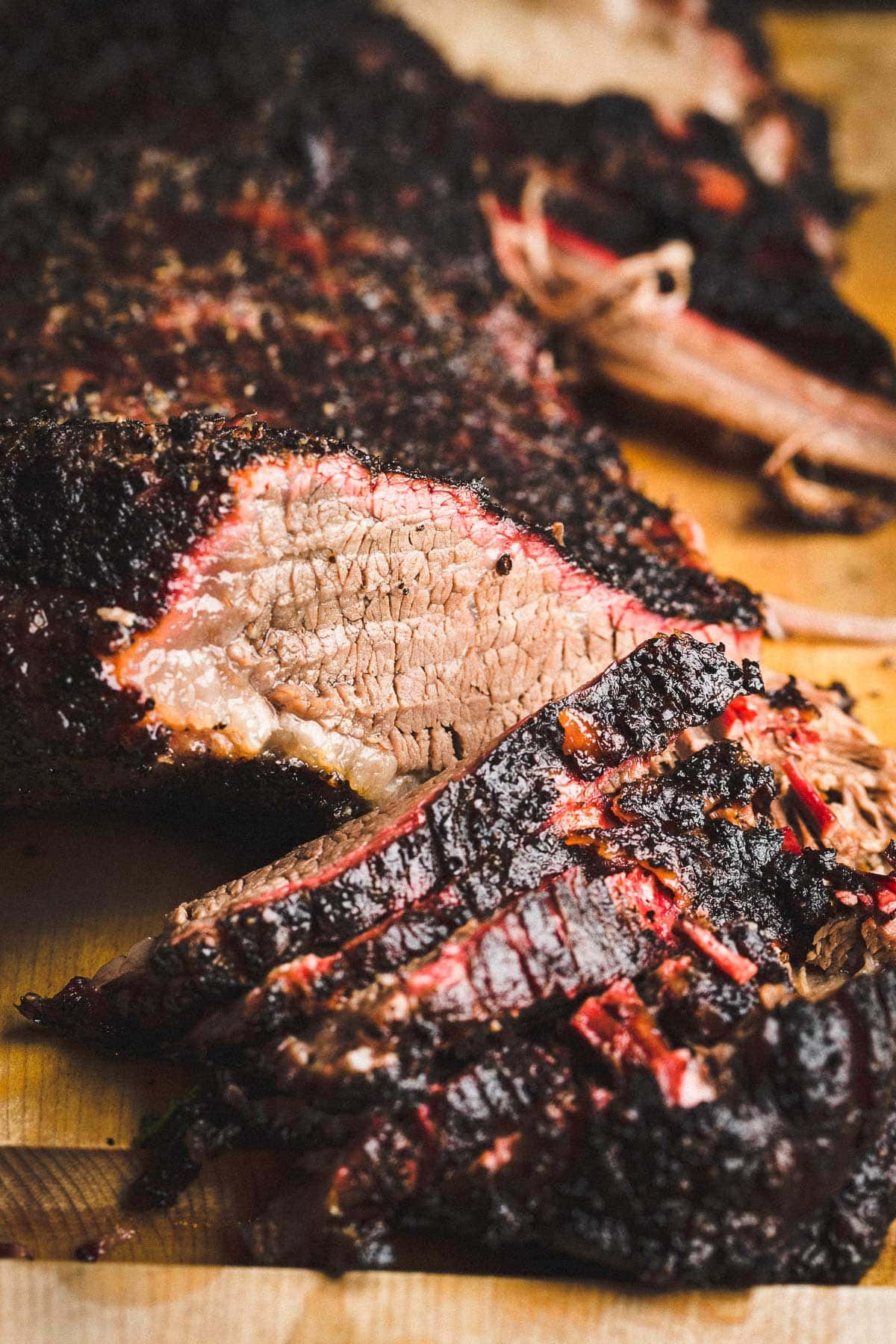
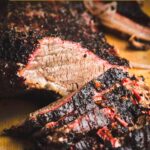
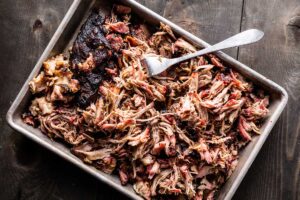
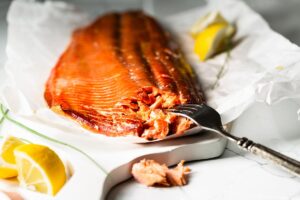
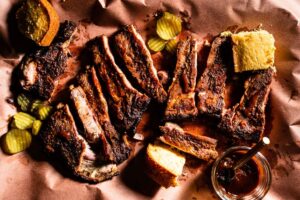
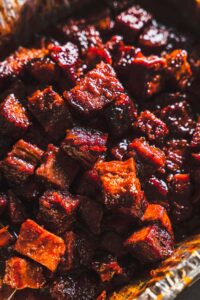
I smoked my first brisket following your recipe and directions. I over-estimated the amount of time it would take to cook. My 14lb brisket only took 5 hours to reach 165 and then 3.5 more hours to reach 203. Thankfully I have a wi-fi enabled smoker and checked the temp often. After I pulled it off, I wrapped heavy duty foil over the butcher paper and then wrapped in a towel and slid it into a 5gal drink cooler on its side. I kept it there for 4 hours and then was worried that the temp wouldn’t stay above 140. I removed it and took off the towel and put it in my warming oven at 150 until ready to serve it. Upon unwrapping, it was hot and steamy and so juicy! We sliced and served it to a party of 12, and everyone absolutely loved this meat! My husband was nervous about me serving a brisket that I’ve never done before to company, but it was a winner! Thank you!